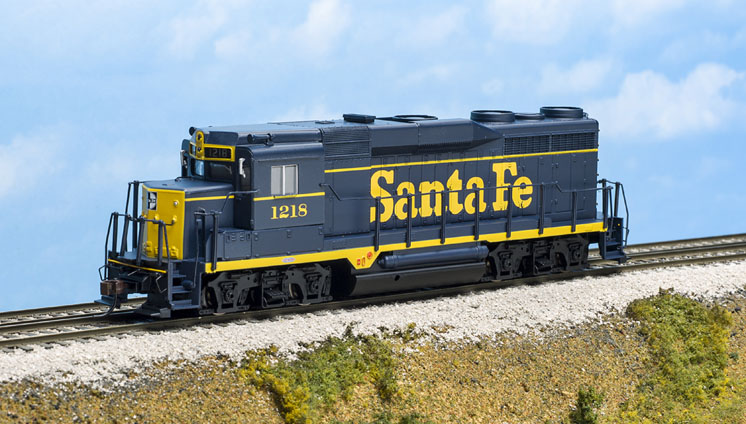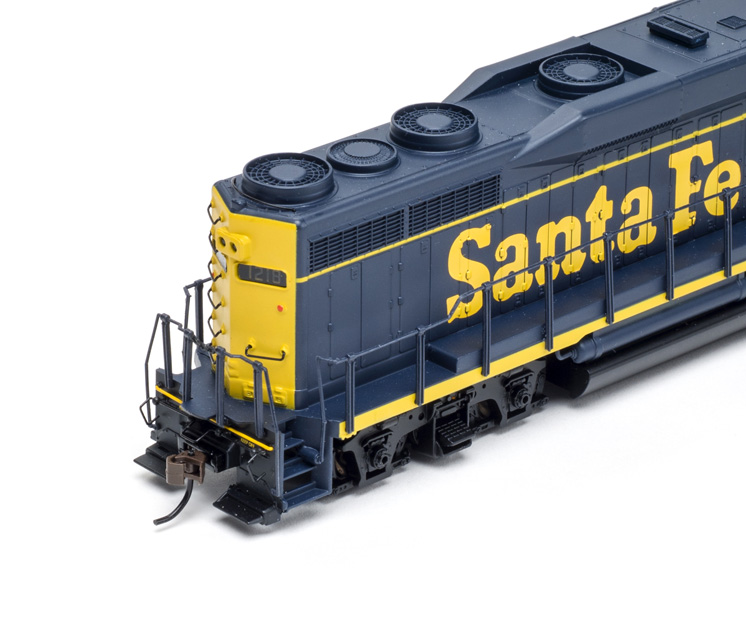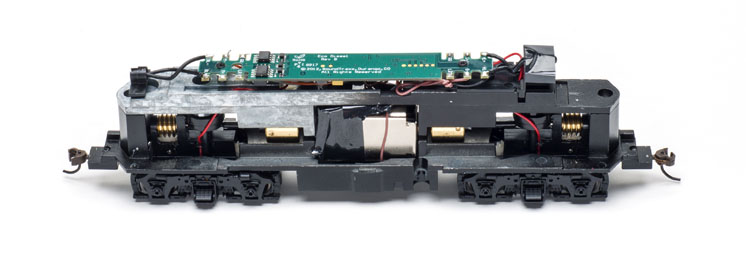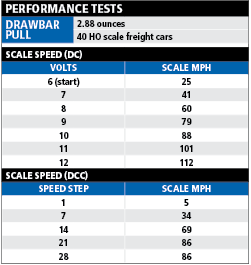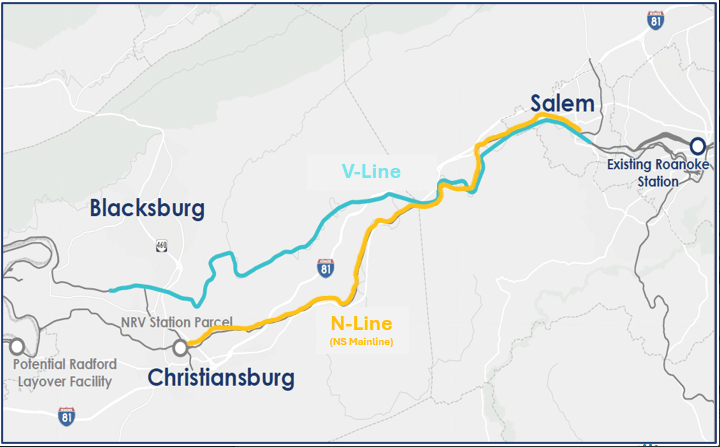Bachmann Trains’ GP30 is now part of the Sound Value line of dual-mode Digital Command Control (DCC)-equipped locomotives. This model was first reviewed by now-retired senior editor Jim Hediger in the December 1988 Model Railroader. While the body shell is largely unchanged, the mechanism has been revised, most recently to accommodate a SoundTraxx Sound Value dual-mode decoder and to create space for a speaker inside the fuel tank area.
Distinctive diesel. Electro-Motive Division’s GP30 made a break from earlier Geeps with its unique roof-top cowling. Designers from General Motors’ Automotive Styling Center came up with the look to integrate the taller electrical cabinet behind the cab.
The fairing continued back over the air filter cabinet, which housed a centralized air distribution system to cool the traction motors, a filtration system for engine intake air, and slightly pressurized the carbody to reduce dust buildup on the internal equipment. The fairing ended in a taper over the dynamic brake housing, even on units that weren’t equipped with that brake option.
Many of these changes were the result of a new competitor in the heavy diesel locomotive market, the General Electric U25B. To compete with the 2,500-hp newcomer, EMD turbocharged its 16 cylinder 567 diesel engine, boosting output to 2,250 hp.
These upgrades over previous GP models worked to the tune of more than 900 units sold to 27 different railroads. While most roads retired their GP30s in the 1980s, Burlington Northern, Chessie System (later CSX), and Santa Fe embarked on various rebuilding programs, extending the life of some of these locomotives to the present day.
The model. Bachmann’s GP30 has a plastic body shell and die-cast metal frame. Separately applied metal grab irons and plastic windshield wipers are among the factory-installed parts. The handrails are molded to scale from flexible engineering plastic.
Windshield wipers on the center, angled windshields are painted on. Bachmann’s model is a Phase II GP30 with the longer cab on the fireman’s (left) side. The longer cab option was first offered in July 1962 and became standard in November 1962.
The overall dimensions of the model are within inches of the prototype, with the exception of the rear truck, which is about 1 foot closer to the center of the locomotive than shown on drawings in the Model Railroader Cyclopedia: Vol. 2, Diesel Locomotives (out of print).
The pilot is open below the coupler pockets, which simplifies removing the chassis from the body shell. Filling this area would require modifying the coupler mounting. The dynamic brake fan and the first radiator fan are molded with open grills. The other body openings are solid. The headlights above the cab are spaced a few scale inches farther apart than seen in prototype photos and drawings.
Our sample was decorated as Santa Fe 1218, a Phase I GP30. Santa Fe 1235 was the first Phase II GP30 Santa Fe had delivered. Santa Fe bought 85 GP30s in two orders. The first, built from April through June 1962, was numbered 1200 to 1234; the second, from January through June 1963, was numbered 1235 to 1284. The railroad also acquired one unit from Toledo, Peoria & Western, built in November 1963, for a total of 86. In the 1980s, Santa Fe’s Cleburn (Texas) Shops rebuilt all of the company’s GP30s, upgrading them to 2,500 hp and reclassifying them GP30u.
Bachmann’s model is painted in the as-delivered “pinstripe” scheme of overall blue with yellow ends and large yellow billboard lettering on the long hood. The yellow paint on the nose and rear end should continue straight across the top of the nose and the rear end.
Detail painting includes EMD builder’s plates on the sill under the cab, red highlights on the fuel filler details, and silver and red paint on the front and rear marker light lenses.
The painting is all opaque, with sharp separation between colors. There are a few voids around the door latches and hinges on the long hood lettering, but that could be easily filled with dabs of paint on a Microbrush or toothpick.
Under the hood. A flywheel-equipped can motor sits in the center of a die-cast metal chassis. It drives all eight wheels through a pair of driveshafts, and all wheels pick up electricity for the SoundTraxx Sound Value decoder.
The decoder is mounted to a full-length weight that spans the model’s trucks, providing their mounting points. Light-emitting diodes illuminate the headlights, rear lights, and number boxes. The fuel tank is a separate plastic part, and it doubles as a retainer for the downward-facing speaker, which sits in a cavity cast into the bottom of the frame.
Removing the body from the frame is simple. First, remove the two screws on the bottom of the fuel tank casting, then remove the casting. Next, remove the two screws in the bottom of the frame casting that screw into the body shell. With the screws removed, the body shell will lift right off.
On the test track. I started testing in direct-current (DC) using our Model Rectifier Corp. Tech 4 power pack. After sounds started at 6V, the model took off at about 25 scale mph. I was able to throttle down to about 5 scale mph, but it was touchy. The top speed at 12V was 112 scale mph, much higher than any EMD gear ratio option could muster. Our pull test indicated the locomotive should pull 40 HO scale freight cars on straight and level track.
To help with DC performance, I set up our MRC Tech 6 sound controller. Raising the configuration variable (CV) for analog motor start voltage (CV63) to a value of 60 gave the locomotive a smoother start. The starting speed and top speed was also reduced to 5 scale mph and 91 scale mph, respectively.
This CV setting also allowed the DC sound effects to work correctly, so the horn sounded two blasts before the locomotive moved forward or three for reverse, and the bell rang while the locomotive was moving under about 10 scale mph. A quick boost of the throttle caused a grade crossing signal to sound.
Digital Command Control operation offered more control. In addition to the horn and bell, dynamic brake sounds can be triggered. Scale speeds, as shown in the chart, were much closer to prototype performance.
Out of the box, there was minimal momentum programmed to the decoder. After changing the locomotive’s address to match the cab number, I increased the value in CV3, acceleration rate, from 6 to 150 (255 is the maximum). I raised CV4, deceleration rate, from 4 to 100. This helped make the model operate more like the 242,000-pound machine it replicates.
I also wanted to change the lighting programming to give me manual control. I set the headlight to turn on and off with F0, and the rear light to turn on and off with F1. I then remapped the bell to F5.
For the lights, I set CV33 and 34 to 1. This made sure the headlight would turn on and off with a push of F0. Then I set CV35 to a value of 2, which made F1 the function button for the rear light. Setting CV49 and 50 to 145 allowed the dimmer on F7 to work. Then I set CV39 to 1, moving the bell to F5.
With the programming complete, I took the locomotive to the Milwaukee, Racine & Troy staff layout. The GP30 pulled a 15-car train up the 1.5 percent grade leading to the summit of the layout at Winter Hill. Coming down the 3 percent grade on the other side with that train, I noticed a bit of gear noise, but the locomotive was running smoothly. There was no noise taking the same train down the 1.5 percent grade.
Switching the train in Bay Junction went smoothly, with the sound of the EMD 567D3 diesel engine rising and falling as I coupled smoothly to the cars and delivered them to their spots. The GP30 navigated the no. 6 turnouts of the yard at Bay Junction with no difficulties.
Once I made a few tweaks to the decoder in the Bachmann GP30, I had a smooth-running and fun-to-use locomotive. If you’re in the market for some early second-generation power, be sure to give this Geep a look.
Manufacturer
Bachmann Industries Inc.
1400 E. Erie Ave.
Philadelphia, PA 19124
www.bachmanntrains.com
Era: 1962 to 1980s, as decorated
Road names: Santa Fe, B&O (sunburst herald), Pennsylvania RR, Southern Pacific (bloody nose), Union Pacific
Features
• All-wheel drive and electrical pickup
• E-Z Mate Mark II couplers, at correct height
• Flywheel-equipped can motor
• SoundTraxx Sound Value decoder
• Turned metal wheels, in gauge
• Weight: 13.1 ounces





